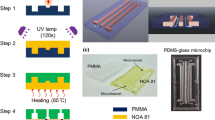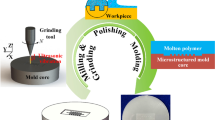Abstract
The challenge of fabricating geometries with critical dimensions ranging from few microns down to 10 nm with high production rate is delaying the development of nanotechnology based products. Diverse research works have shown the capability of technologies such as UV lithography, nano imprint lithography and e-beam lithography to produce micro and nano features. However, their application for tooling purposes is relatively new and the potential to produce nanometer features with high volume and low cost is enormous. Considering possible implementation in a mass production environment the precision of measuring results and the accuracy of measurement relocation are very relevant. In this paper, the capability of producing with high volume Lab-on-chip devices through injection molding is evaluated. Preparation of master geometries was made in a Si wafer using e-beam lithography and reactive ion etching. Subsequent nickel electroplating was employed to replicate the obtained geometries on the tool, which was used to mold on transparent polymer substrates the functional structures. To assess the critical factors affecting the replication quality throughout the different steps of the proposed process chain, test geometries were designed and produced on the side of the functional features. The so-called “Finger Print” of the lithography and molding processes was qualitatively and quantitatively evaluated through scanning electron microscopy and atomic force microscopy respectively. The entire process chain is therefore characterized and the degree of replication among the different replication steps quantified with precise measurements using a high accuracy relocation technique on the produced key test geometries. Influence of injection molding process parameters, feature dimensions and orientation relative to the polymer flow direction have been assessed in respect of the replication fidelity of the produced micro/sub-μm channels. Finally the paper addresses product compliance with specifications, focusing on tolerances of vertical dimensions using a metrological approach: sub-μm features on silicon, nickel stampers and injection molded substrates are measured. Results of measurement uncertainty calculation, quantitative replication fidelity assessment, and dimensional tolerances at the nanometer scale verification are reported.











Similar content being viewed by others
References
Anderson H, Van Den Berg A (2003) Microfluidic devices for cellomics: a review. Sens Actuat 92(3):315–325
Becker H, Locascio LE (2002) Polymer microfluidic devices. Talanta 53(2):267–287
Choi SH, Kim DS, Kwon TH (2009) Microinjection molded disposable microfluidic lab-on-a-Chip for efficient detection of agglutination. Microsyst Technol 15(2):309–316
Clayton J (2005) Go with the microflow. Nat Methods 2(5):621–627
Curtis A, Wilkinson C (2001) Nanotechniques and approaches in biotechnology. Trends Biotechnol 19(3):97–101
Duffy DC, McDonald JC, Schueller OJA, Whitesides GM (1998) Rapid prototyping of microfluidic systems in poly(dimethylsiloxane). Anal Chem 70:4974–4984
Figeys P, Pinto D (2000) Lab-on-a-Chip: a revolution in biological and medical sciences. Anal Chem 72(9):330–335
Galhotra V, Sangishetty V, Ma E, Kelly K (1995) Electroplated nickel mold insert for LIGA, proceedings of SPIE. Intern Soc Optical Eng 2639:158–160
Guide to the Expression of Uncertainty in Measurement (GUM) (2008) JCGM 100:2008, pp. i–viii, 1–132
Hansen HN, Hocken RJ, Tosello G (2011) Replication of micro and nano surfaces technologies. Ann CIRP Manufact Technol 60(2):695–714
Image Processing Software for Microscopy (SPIP). http://www.imagemet.com/
Marinello F (2006) Atomic force microscopy in nanometrology: modeling and enhancement of the instrument, Ph.D. Thesis. University of Padua, Technical University of Denmark, Italy, Denmark
Matschuk M, Bruus H, Larsen NB (2010) Nanostructures for all-polymer microfluidic systems. Microelectron Eng 87(8–8):1379
Nunes PS, Ohlsson PD, Ordeig O, Kutter JP (2010) Cyclic oleofin polymers: emerging materials for Lab-on-a-Chip applications. Microfluid Nanofluid 9:145–161
Tosello G, Antico A, Hansen HN, Marinello F, Lucchetta G (2009) Influence of measuring parameters on the accuracy of atomic force microscope in industrial applications, 5th Int. Conference on Multi-Material Micro Manufacture (4 M/ICOMM), pp. 401–406
Tosello G, Hansen HN, Marinello F, Gasparin S (2010) Replication and dimensional quality control of industrial nanoscale surfaces using calibrated AFM measurements and SEM image processing. CIRP Ann Manufact Technol 59(1):563–568
Utko P, Persson F, Kristensen A, Larsen NB (2011) Injection molded nanofluidic chips: fabrication method and functional tests using single-molecule DNA experiments. Lab Chip 11(2):303–308
Villarrubia JS (1997) Algorithms for scanned probe microscope image simulation, surface reconstruction and tip estimation. Res Nat Stand Technol 102(4):425–454
Acknowledgments
The present research was carried out within the National Danish Strategic Research Center POLYNANO (http://www.polynano.org/) supported by the Danish Council for Strategic Research. Also the collaboration of the National Institute of Metrology, China (NIM) is greatly acknowledged.
Author information
Authors and Affiliations
Corresponding author
Rights and permissions
About this article
Cite this article
Calaon, M., Hansen, H.N., Tosello, G. et al. Microfluidic chip designs process optimization and dimensional quality control. Microsyst Technol 21, 561–570 (2015). https://doi.org/10.1007/s00542-013-2025-3
Received:
Accepted:
Published:
Issue Date:
DOI: https://doi.org/10.1007/s00542-013-2025-3




